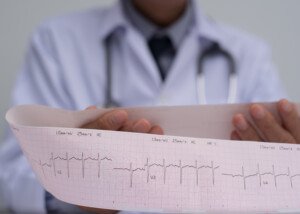
It’s amazing that only 30 milliseconds—the blink of an eye—is the difference between a normal heart & one that’s at risk for suddenly stopping due to LQTS.
Before each beat, the heart repolarizes or recharges. This is supposed to take place within a certain time frame that takes only milliseconds.
If there’s a delay of even 20 milliseconds (depending on the QTc interval you use as a reference), this will put a person at risk for sudden cardiac arrest.
And by the way, 20 or 30 milliseconds are actually about one-tenth the time it takes for the average eye to blink.
“In the heart’s ‘clock,’ 30 milliseconds is a significant amount of time to make a difference in increasing the risk of a cardiac event,” says Paul Rogers, MD, PhD, Medical Director, Cardiac Rhythm Device Clinic, Ochsner Health System.
The interval on an EKG between the Q wave and T wave is called the QT interval.
When it is “corrected” relative to pulse rate, this is called QTc.
A normal QTc for men is under 440 milliseconds and for women under 460 milliseconds.
These numbers can vary depending on the formula that’s used to calculate the QTc.
If you’re a woman and have noticed that your QTc was calculated to be 458 ms, do not panic – especially if you’ve had a lifetime of grueling exercise, swimming and highly charged emotions (all risk factors for a sudden cardiac arrest, depending on the type of LQTS) without any incidents of fainting, let alone cardiac arrest.
Remember, milliseconds count.
“It is well-established that emotional stimuli can trigger an event in patients with LQTS 2,” says Dr. Rogers.
“Patients with LQTS 1 are prone to events during exercise.
“Both LQTS 2 and 3 can have events during sleep.
“I would recommend any patient with LQTS be followed regularly by a cardiologist who has experience in this field.
“It requires active ongoing surveillance, monitoring of response to medical therapy, and education. Some patients will do well with medications alone.
“Some patients who are deemed very high risk of sudden death may also end up needing an implantable cardiac defibrillator.
“Also, it is very important that once someone is diagnosed with genetic LQTS that all of their first-degree relatives get screened as well.”
 Dr. Rogers has clinical interests in complex heart arrhythmias and the benefits of implantable cardiac device based therapies in patients with reduced heart function.
Dr. Rogers has clinical interests in complex heart arrhythmias and the benefits of implantable cardiac device based therapies in patients with reduced heart function.
 Lorra Garrick has been covering medical, fitness and cybersecurity topics for many years, having written thousands of articles for print magazines and websites, including as a ghostwriter. She’s also a former ACE-certified personal trainer.
Lorra Garrick has been covering medical, fitness and cybersecurity topics for many years, having written thousands of articles for print magazines and websites, including as a ghostwriter. She’s also a former ACE-certified personal trainer.
.









































